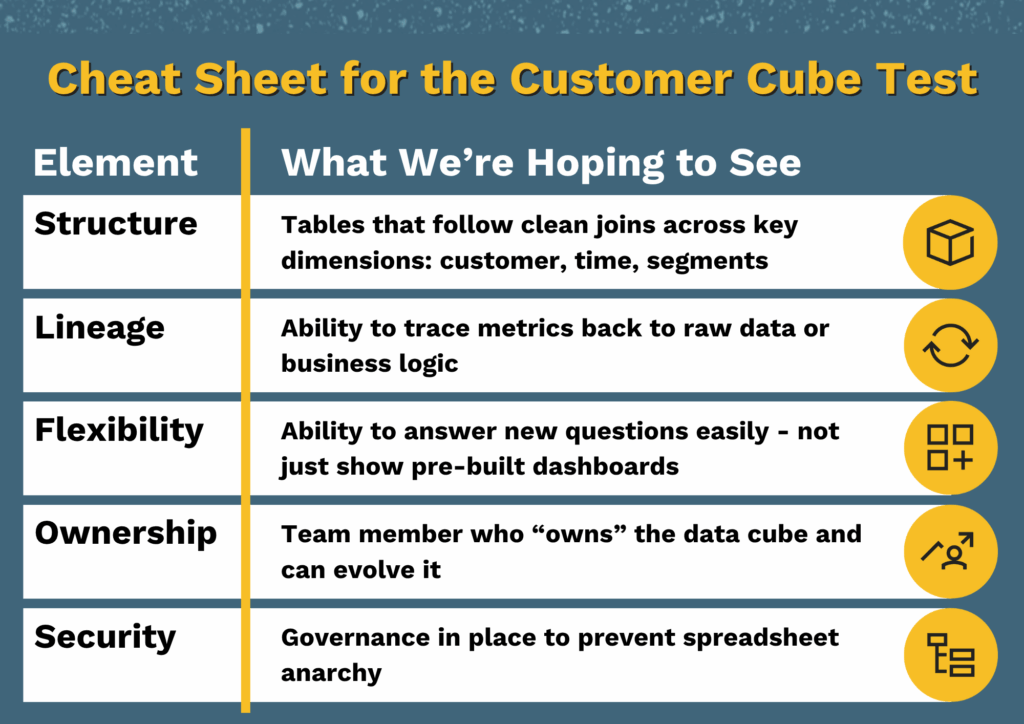Insights
Don’t Panic! But It’s Time to Take Your Data Seriously

“A towel, it says, is about the most massively useful thing an interstellar hitchhiker can have.” — The Hitchhiker’s Guide to the Galaxy, by Douglas Adams
I’d argue the modern equivalent to a time traveler’s towel for any company is a clean, structured, query-ready customer dataset. Call it your towel, your lightsaber, or your sidekick — but it’s time to have one. And know where it is. You likely hear terms like “customer cube” or “data cube” tossed out, or get specific retention requests. So, stop micromanaging your dashboards and make sure your business can answer the hard questions quickly, credibly, and consistently. Today we’ll look at:
- Why data hygiene matters more now than ever
- How AI makes this not just possible, but potentially profitable
- And yes, what not to panic about
The Data Hygiene Wake-Up Call
Let’s be honest: most companies have data in silos, often wrapped in duct tape and tribal knowledge. Finance pulls one number, Support pulls another, Sales swears by their version, etc. That’s fine — until you’re asked a question like:
“What’s our net retention over the last three years by product line and sales channel?”
Cue the spreadsheet scramble, distressed Teams chats to the RevOps lead, and a silent prayer that the old SQL script still works.
This scenario is why it’s so important to create a customer data cube — not a monolithic build, but a flexible, structured, verifiable base from which any important customer metric can be sliced. It’s not enough to have data. You need confidence in your data, and the ability to explore it without a PhD in pivot tables.
Why AI Without Data Discipline is Just Noise
We’re all hearing the pitch: “Use AI to boost productivity! Write emails! Analyze churn!” But here’s the uncomfortable truth: AI without structured data is like a wet towel full of holes — not much use when you actually need it.
You can’t ask large language models (LLMs) to summarize customer insights if the source information is inconsistent. You can’t automate sales contract review if every agreement is a one-off Word doc with no tagging. You can’t build a real churn predictor if customer lifecycles aren’t normalized.
But you can do all those things, and do them easily, once you take data hygiene seriously. Okay, you can also do these things with ad hoc unstructured data, but it’s more challenging and takes longer. For example:
- Sales Contract Review: Imagine using AI to automatically flag unusual payment terms, auto-renewal clauses, or discount patterns across your customer base. But before you can do that, you need digitized contracts and a way to link them to the customer’s lifecycle. As an example, you can do quick comparisons of how agreements have changed over time as well as customer-to-customer comparisons. But you can’t do that without a good data set as a starting point.
- Customer Health Scores: Want to know which customers are at risk of churning? AI can help, but only if usage, support tickets, billing, and relationship data live in the same solar system.
- Scenario Modeling: Curious how a 5% pricing change would affect gross margin by product line? This exercise works only if you can query for clean, normalized revenue data over time.
In other words: clean data isn’t a luxury — it’s tablestakes for making AI useful.
Do You Have the Right Stuff? Checking Your Customer Cube
If you’re not sure if you have the data you need, run a test on your customer cube. Attempt to pull metrics like customer count, revenue expansion, and churn across time, products, regions, and segments. Prepare to answer any questions your executive teams or owners might ask to understand how flexible your data platform is. You should be able to pull these in minutes, not days. Now’s the time to invest in the “plumbing” if you haven’t already.
Here’s a quick cheat sheet for what to look for.

These elements don’t necessarily mean you need a Snowflake data warehouse. If you are using Snowflake, then that’s great. You do however need something better than “Fred’s Master Metrics File v17.xlsx.”
Where to Go From Here
The goal is to level up, no matter where you currently stand. As you build this foundation, remember:
- Your CFO will thank you during board prep
- Your CRO will thank you when modeling pricing
- Your CTO will thank you when chasing system debt
- Your CMO will thank you when targeting campaigns
Final Words (and a Friendly Reminder)
“Would it save you a lot of time if I just gave up and went mad now?” — The Hitchhiker’s Guide to the Galaxy
This effort doesn’t have to be perfect. It just has to be real, usable, and evolving. So, don’t panic, but don’t delay. Your data cube is your towel. Keep it clean, keep it ready, and never let it out of sight.









